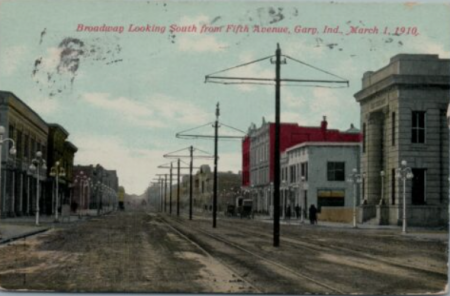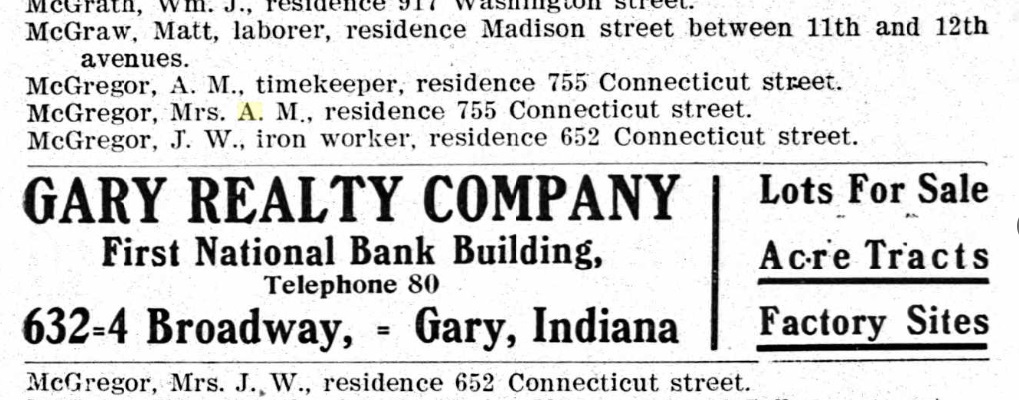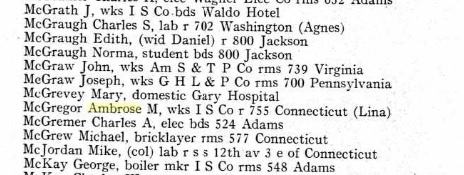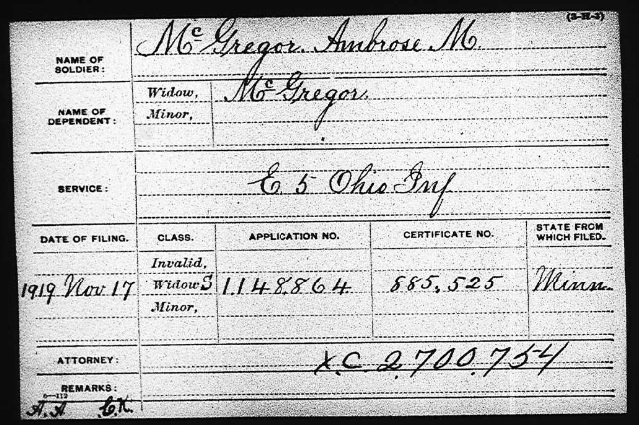
by Laura Stolk
March 20, 2020
A CASE STUDY OF LENA GILLIS MCGREGOR, WHO WAS LIKELY MISLABELED AS A CONCUBINE
This research centers on the discovery of a woman who was born in 1873, who was listed in the 1910 Census in Gary, Indiana with the relation to head of household as “concubine”. This was a surprise to me as I’ve seen many census entries and have never witnessed this term used.
In 1910, Lina McGraw lived in Gary, Lake County, Indiana (just outside of Chicago). Her marital status was “single” and and she was named as the concubine of Andrew McGregor. Andrew’s status was listed as “MD”.

In looking closely at this entry, here is what I see: Lina (spelled “Lena” on this census) was born in Illinois and her parents were born in Pennsylvania. Her father’s surname was McGraw, since she was not listed as “widowed” or “divorced” and she had a child and that was still living. Under the column listing the number of years married, for Lina it stated “10” even though she was listed as single.
For Andrew, that column was blank. The column indicating marital status for Andrew has “MD”. This is a strange entry because it should either be “M” or “D”, not both. In fact the instructions to the enumerators of the 1910 census do not indicate that this is an actual term at all:
“113. Column 8. Whether single, married, widowed, or divorced. Write ‘‘S’’ for single or unmarried persons; ‘‘Wd’’ for widowed (man or woman); ‘‘D’’ for divorced; for married persons, inquire whether they have been married before, and if this is the first marriage, write ‘‘M1,’’ but if this is the second or subsequent marriage, write ‘‘M2’’ (meaning married more than once).”.
There was a child, Robert, in the household who was ten years old and his mother was born in Illinois. So, I can surmise that Lina was Robert’s mother. Robert’s last name was McGregor, which matches Andrew’s surname. Also, they had a lodger named Clair Sykes, who was a bricklayer from England. Andrew and Clair both worked at the steel mill.
I looked for other McGraws in the area and found Charles, age 40 and married, and Michael, age 25 and single. Both men lived very close to Lina, as in you could walk to all three residences in 15 minutes. Clues from their census files were few in regard to Lina. For instance, the place of parents’ birth was “U.S” and therefore not an exact match to Lina’s parents, yet not a contradiction, either. Charles and his wife had three living children, but none in the household. Michael was also born in Pennsylvania. He was a bricklayer at the grocery car barn. A relationship to Lina could not be found.
I thought perhaps Lina was considered Andrew’s concubine and not his wife because they were in a situation now known as common law marriage. However that turned out not to be the case because further searching revealed the 1900 census for them…and Lina was listed as his wife. Some of the information on the 1900 and 1910 census did not match perfectly – places of parents’ birth, birth years – but that is common in census reports. Information changes according to who was doing the reporting and mistakes were also sometimes made.

A bit on the Mann Act, which was passed on June 25, 1910:
This then new federal law was put in place to put a stop to “white slavery” – the selling of women for the purposes of prostitution, specifically across state lines. News articles from the time point out that this law was not designed to inhibit men from traveling around the country with their concubines. So, my conclusion about that term for the time period is that a concubine was an unmarried woman cohabitating in a consensual relationship with a man.
(Of note, the way in which the Mann Act was worded, left open the idea that interracial marriages could be criminally prosecuted. According to this research, though, this did not apply in Lina’s circumstance, as both Lina and Andrew were the same race.)
When a spouse died in those times, the surviving spouse would often remarry, usually quickly. However, there were some reasons for not remarrying. If a spouse abandoned the marriage, a divorce might not be awarded if a judge thought there could be possibility of return. Therefore the remaining spouse could not legally remarry. If a surviving widow wanted to keep her widow’s pension, yet found a new love interest, she (or they) might have chosen to co-habitate, without remarrying.
In the case of Lina McGraw and Andrew McGregor, though, she was first listed as “wife” and ten years later, “concubine.” I could guess that the census taker assumed legal marriage in 1900, or they just said “married.” After Andrew died, Lina used the surname McGregor and was listed as “widow.” In 1930, the census stated that she was a widow who had been married for 20 years.
Also, the name McGraw was entirely puzzling, as I came to find out that her maiden name was Gillis.
A review of the other McGraw’s in Gary Indiana at the turn of last century indicates there were Charles and Matt McGraw. In 1908, there was just one, and his relationship to Lina, if any, is unknown:

There was also a lady named Lena Travis that lived next door to Ambrose and Lina in 1910. She married John McGraw not long after that.
After the 1910 census, I could not find “Andrew” McGregor any longer. I did find Lina McGregor, consistently living with her son, Robert. They first moved to Minneapolis where Robert worked as a repairman at an auto company. Lina and her son later moved to Richmond, California and they remained there for many years. Robert worked for the Standard Oil Company.
There is a common thread with Andrew using his initials as “A.M.” and Lina listing herself as the widow of “A.M.” McGregor. In 1932, in the city directory, she was listed as the widow of “Ambrose M. McGregor”. So, a quick search of city directories turned up Ambrose M. McGregor, husband of Lina, living at 755 Connecticut in Gary, Indiana in 1911. This is the exact address where Andrew and Lina lived in 1910. So, Andrew and Ambrose are the same person.
The discovery of the name “Ambrose” led to the finding of their marriage record, which verified her maiden name as Gillis, not McGraw. They were married in 1899, in Chicago.


More searching of Ambrose McGregor turned up the fact that his uncle, of the same name, was one of the founders and the President of the Standard Oil Company. Ambrose’s parents were Alexander and Isabella McGregor, whose parents were born in Scotland and Ireland, respectively. The fact that Robert worked for the Standard Oil Company, was probably not coincidence. In fact, Ambrose’s uncle was very well situated and took care of many of his relatives upon his death, leaving an estate worth 8 million dollars.
Ambrose had a cousin, who was the son of his Uncle Ambrose, named Bradford B. McGregor. Bradford died young – one day after his second marriage- due to complications following a kidney operation. His funeral was well-attended and famous names such as John D. Rockefeller and H. M. Flagler were mentioned in his obituary. He left 4 million dollars to his wife of one day.
In 1913, Ambrose McGregor was no longer listed in Gary. In 1914, Ambrose was listed in the Cleveland directory. He continued to be listed in Cleveland until he died in 1918. Lina was never listed there as his wife, nor as a widow the years after.
There is a burial record for Ambrose McGregor, which verifies his date of death as 1918 and burial location as Mt. Pleasant Cemetery in Geneva, Ashtabula County, Ohio, USA. This is where his parents are buried, as well.
Lina filed a widow’s pension in 1919 from Minnesota.

The timeline suggests that the McGregors left Gary, Indiana in 1912 and lived in Cleveland. When Ambrose died, Lina and Robert moved to Minneapolis where they lived from about 1918 to 1922. After that, they moved to Contra Costa, California. They were likely moving according to Robert’s job with the Standard Oil Company.
They lived not far from the Golden Gate Bridge in San Francisco.
Lina died on May 10, 1945. Her death record also states that her maiden name was Gillis. She is buried at the Sunset View Cemetery near Berkeley.

Her son, Robert, died in 1979 in Nevada, though his permanent residence remained in California.
We still do not know why Lina was listed as “concubine” with the last name “McGraw” in 1910. My tentative conclusion is that Ambrose and Lina were in the process of divorcing. The surname “McGraw” is still a mystery, as she never used that name again and eventually listed herself as the widow of Ambrose McGregor. Another theory is that the census taker confused Lena Travis, from next door, who was about to marry John McGraw, with Lina McGregor.
A side note: An interesting fact about the McGregor surname is that it originated in Scotland. At one point the entire McGregor clan provoked the ire of the King and they were banished and stripped of their surname. The clan moved to Tyrone, Ireland where they took the name “McGraw”. They did not remain long in Ireland before moving to North America, long before the United States were formed. So, I find it very interesting that in this research piece, I am searching for both of those surnames.
